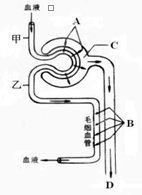图为肾单位中形成尿液示意图.据图回答下列问题:
(1)图中A代表的生理过程______;
(2)C中液体与D中液体不同,主要区别是D中没有______.
(3)请写出乙血管的名称______.甲和乙中所流的血液类型相同吗?______.
(4)当膀胱中的尿液达到一定量时,人体会产生尿意,尿意形成的部位是______.

(1)肾单位包括肾小体和肾小管两部分,肾小体又包括肾小球和肾小囊;尿的形成过程包括肾小球的滤过作用和肾小管的重吸收作用.所以当肾动脉血浆中的尿素随血液由入球小动脉流经肾小球时,血浆中的一部分水、无机盐、葡萄糖、尿素等滤过到肾小囊腔中形成原尿,当原尿流经肾小管时,大部分对人体有用的物质(如:大部分水、全部葡萄糖和部分无机盐)又被肾小管重新吸收进入血液.而剩下的物质,如尿素、一部分水和无机盐等由肾小管流出,形成尿液.因此,图中A代表的生理过程 肾小球的过滤作用;
(2)由于原尿在流经肾小管时,重吸收了全部葡萄糖,因此,C中液体原尿与D中液体尿液不同,主要区别是D中没有葡萄糖.
(3)血液流经肾小球时没有发生气体交换的作用,只进行了过滤作用,因此图中甲入球小动脉内和乙出球小动脉内流动的血液类型相同,都是动脉血.
(4)排尿反射是由反射弧来完成的,当膀胱内尿液积累达到一定量时,会使膀胱内的感受器产生神经冲动,冲动沿传入神经传导到位于脊髓内的神经中枢,神经中枢将冲动上传到大脑皮层的躯体感觉中枢形成尿意.在适宜的环境下,躯体运动中枢将冲动下传到排尿神经中枢,再通过传出神经到达效应器- * * 括约肌.括约肌舒张,尿液就从膀胱经 * * 排出体外.因此,当膀胱中的尿液达到一定量时,人体会产生尿意,尿意形成的部位是大脑皮层.
故答案为:
(1)肾小球的过滤作用;
(2)葡萄糖;
(3)出球小动脉;相同;
(4)大脑皮层(或大脑)
